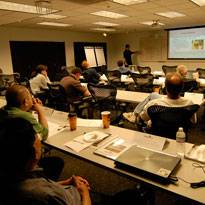VoIP
- Course:VoIP
- Course ID:VOIP Duration:2-3 days Where: Your Office (7+ Persons)
- Download Course Description (PDF)
Available as a private, customized course for your group at your offices or ours and in some cases as a WebLive(TM) class.
Course Outline
- Introduction
- Limitations of traditional telephony
- VoIP vs. traditional telephony: Advantages and disadvantages
- History
- Commercial Markets and Applications: Why Is VoIP Being Adopted So Readily?
- Business applications
- Distributed sites
- Remote/home workers
- The Big Picture: VoIP Systems Architecture
- Deployment models for VoIP in an enterprise
- Vendors and the basics of their offerings
- Basics of TCP
- VoIP Protocols
- SIP
- H.323
- Others
- VoIP Compression Methods
- VoIP and QoS
- Network Delay considerations
- VoIP Devices and Systems
- Gateways
- Media servers
- Application servers
- Registrars
- Proxy servers
- VoIP Provider/Carrier Considerations and Planning
- System Planning and Design
- Design
- Wide area networking considerations
- Migration strategies
- VoIP Implementation: Management Best Practices
- Disaster Recovery
- Security Issues
- Troubleshooting in a VoIP Environment
- Wrap-up: System View
- Putting it all together
- End-to-end performance
- Future of VoIP communications
- (Optional) Action Learning Workshop (third day)
- Develop a high-level design
- Use appropriate tools (Internet connection required) to size network requirements
- Build endpoint requirements plan
- Data network impact considered
- Select deployment model and procurement requirements
Course in a Nutshell
It is not easy to master VoIP. It’s a complex technology. The introduction and popularity of SIP means truly open system standards and options that are not vendor specific. Added to this, there are many deployment options available. Given this complexity, it’s no surprise that IT and telecom engineers find it hard to determine the optimum design and deployment choices for their environment. If you are a technical manager or professional, this course will help you understand the concepts, design considerations, and deployment models for VoIP. We will introduce you to the underlying protocols, compression methods, and network impact. We will study the design considerations for distributed locations and remote/home workers. We will also study the physical and application layers regarding gateways, media servers, and endpoints. Planning and design exercises will help you make the bridge from the theory to the applications of VOIP. All in all, the course will help you acquire an in-depth understanding of the VoIP technology. You can turn this course into an Action Learning Workshop by extending it to three-days with the addition of a “workshop day” devoted to a case study specific to your organization. This applied learning day can help you learn while you build a VoIP design and procurement requirements document for your own organization.
Customize It!
- Are you involved with a VoIP rollout or migration? In addition to this course, aimed at the more technical audiences, the course is also available in a managerial/executive version. See Related Courses above.
- Are you a network or IT engineer who would like to “fill in the holes” and catch up with the state-of-the-art of VoIP protocols and design? Let us know so we can focus on the areas that interest you the most.
- Are you a network/LAN installer who would like to learn the concepts and theory that underlie your craft when moving into VoIP? We can focus on the tools and techniques that will help you become more “tech savvy”.
- Are you a technical manager, executive, or sales person whose work involves VoIP communication systems? If so, we can emphasize those parts of the course that deal with the markets and applications pertinent to your project or product.
- Turn this course into an action learning program by adding a “workshop day” to draft a design and procurement requirements document to acquire the appropriate equipment, carrier bandwidth, endpoints, systems, and prepare a sound pre-implementation plan. This will help you apply what you learned in the first two days while solving problems specific to your organization.
Learn How To
- Assess the strengths and limitations of VoIP vis-à-vis traditional telephony
- Describe the current markets, applications, and network providers for VoIP
- Understand the key components of a VoIP design and how they fit together
- Describe the conceptual and theoretical underpinnings of your field
- Understand the VoIP protocols and their importance to your design
- Appreciate bandwidth considerations and apply compression methods
- Characterize VoIP’s impact on your network and QoS
- Learn VoIP provider concepts
- Develop a VoIP deployment plan
Aimed At
Communications, systems, and software engineers; network, IT, and marketing/sales professionals; technical or strategy managers or consultants, and others who plan to evaluate, design, build, or work with VoIP networks, applications, and services.
Prerequisites
While there are no specific prerequisites for this course, a technical background and prior exposure to telecommunications or IT issues will be very helpful.
- "Instructor had tremendous knowledge of the subject ... relevant and topical stories ... great at generating class participation." – Leading Technology Consulting Company

